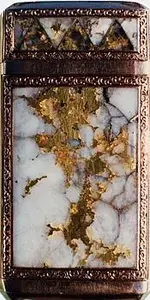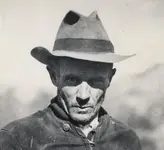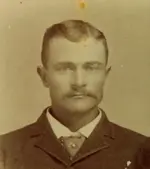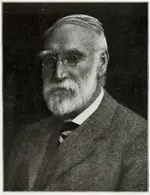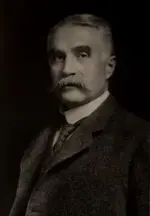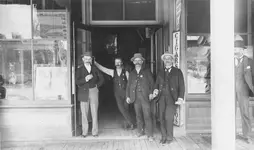Oroblanco
Gold Member
- Joined
- Jan 21, 2005
- Messages
- 7,841
- Reaction score
- 9,876
- Golden Thread
- 0
- Location
- DAKOTA TERRITORY
- Detector(s) used
- Tesoro Lobo Supertraq, (95%) Garrett Scorpion (5%)
- #741
Thread Owner
Cactusjumper wrote
You think that is the same thing? The ore used for Bob's ring, came from a trusted source. That source proved to be untrustworthy. With the ore used to make the matchbox, and the other jewelry, came from Dick Holmes. Holmes stated the gold ore came from the candlebox found under Waltz's deathbed. Holmes then spent the remainder of his life searching for the mine from which that ore came. Likewise for his son, and his partner Clay Wurst. Wouldn't you agree that is a rather different provenance, than the ring ore and the Kochera ore for that matter?
Further, would you not agree that the gold ore used to make that famous matchbox and jewelry, came from a gold mine? Your doubts do not seem warranted from my point of view, despite the years of false information and what certainly appears to be mixing of several different lost mines into one impossible tale, we have at the root, a man named Jacob Waltz, widely known for having been a prospector, rather a successful one, and that he had a gold mine. Not a silver mine, a gold mine.
Even more, consider that the Ludy/Peralta lost mine story has many of the identical elements we find in the LDM legend. Does that not raise red flags for you, that perhaps the Ludy/Peralta story got mixed together with the LDM? After all we do have a very different version of the Lost Dutchman that has no Peraltas, no massacre, no huge funnel shaped pit and tunnel beneath, in fact about the only links are the drywasher and that it was a gold mine! Would you grant that it is POSSIBLE that someone, Holmes perhaps, or Julia, or perhaps even Waltz himself, confused or deliberately mixed the Peralta/Ludy story with Waltz? Remember, one of the Ludys was named Jacob, and this became garbled (by Barry Storm) into Jacobs and Ludy, when really it was one man named Jacob Ludy and the other Ludy I have forgotten the name. It is even possible that the Ludys were uncle and nephew, for there was 18 years age difference between them according to their enlistment papers. And that they were Civil War soldiers, went to Mexico where they met Peralta and etc etc. Do you accept that both the Ludys and Waltz and Weiser were all Civil War soldiers, they all met Peralta and worked for him, and were all given the mine as repayment?
Real de Tayopa wrote
Hmm then either you are not receiving my emails, or you are not reading them. Did you not receive emails from me over the past several years?



Roy,
The problem with the "Dutchman Ore", at least for me, is that it's possible that Waltz never saw or touched the samples that are credited to his mine. It's similar to the "Hell I Was There" syndrome I have mentioned before. I imagine there was a plethora of Waltz ore produced once the story hit its stride. Pretty much like Bob's ring. He believed what he was told, which was false. Like all such ore, it's of course, possible it came from the LDM.
You think that is the same thing? The ore used for Bob's ring, came from a trusted source. That source proved to be untrustworthy. With the ore used to make the matchbox, and the other jewelry, came from Dick Holmes. Holmes stated the gold ore came from the candlebox found under Waltz's deathbed. Holmes then spent the remainder of his life searching for the mine from which that ore came. Likewise for his son, and his partner Clay Wurst. Wouldn't you agree that is a rather different provenance, than the ring ore and the Kochera ore for that matter?
Further, would you not agree that the gold ore used to make that famous matchbox and jewelry, came from a gold mine? Your doubts do not seem warranted from my point of view, despite the years of false information and what certainly appears to be mixing of several different lost mines into one impossible tale, we have at the root, a man named Jacob Waltz, widely known for having been a prospector, rather a successful one, and that he had a gold mine. Not a silver mine, a gold mine.
Even more, consider that the Ludy/Peralta lost mine story has many of the identical elements we find in the LDM legend. Does that not raise red flags for you, that perhaps the Ludy/Peralta story got mixed together with the LDM? After all we do have a very different version of the Lost Dutchman that has no Peraltas, no massacre, no huge funnel shaped pit and tunnel beneath, in fact about the only links are the drywasher and that it was a gold mine! Would you grant that it is POSSIBLE that someone, Holmes perhaps, or Julia, or perhaps even Waltz himself, confused or deliberately mixed the Peralta/Ludy story with Waltz? Remember, one of the Ludys was named Jacob, and this became garbled (by Barry Storm) into Jacobs and Ludy, when really it was one man named Jacob Ludy and the other Ludy I have forgotten the name. It is even possible that the Ludys were uncle and nephew, for there was 18 years age difference between them according to their enlistment papers. And that they were Civil War soldiers, went to Mexico where they met Peralta and etc etc. Do you accept that both the Ludys and Waltz and Weiser were all Civil War soldiers, they all met Peralta and worked for him, and were all given the mine as repayment?
Real de Tayopa wrote
No AZDave, I haven't. I gave my ip needle to Oro to play with He hasn; reported back on hhis use of it.
Hmm then either you are not receiving my emails, or you are not reading them. Did you not receive emails from me over the past several years?






